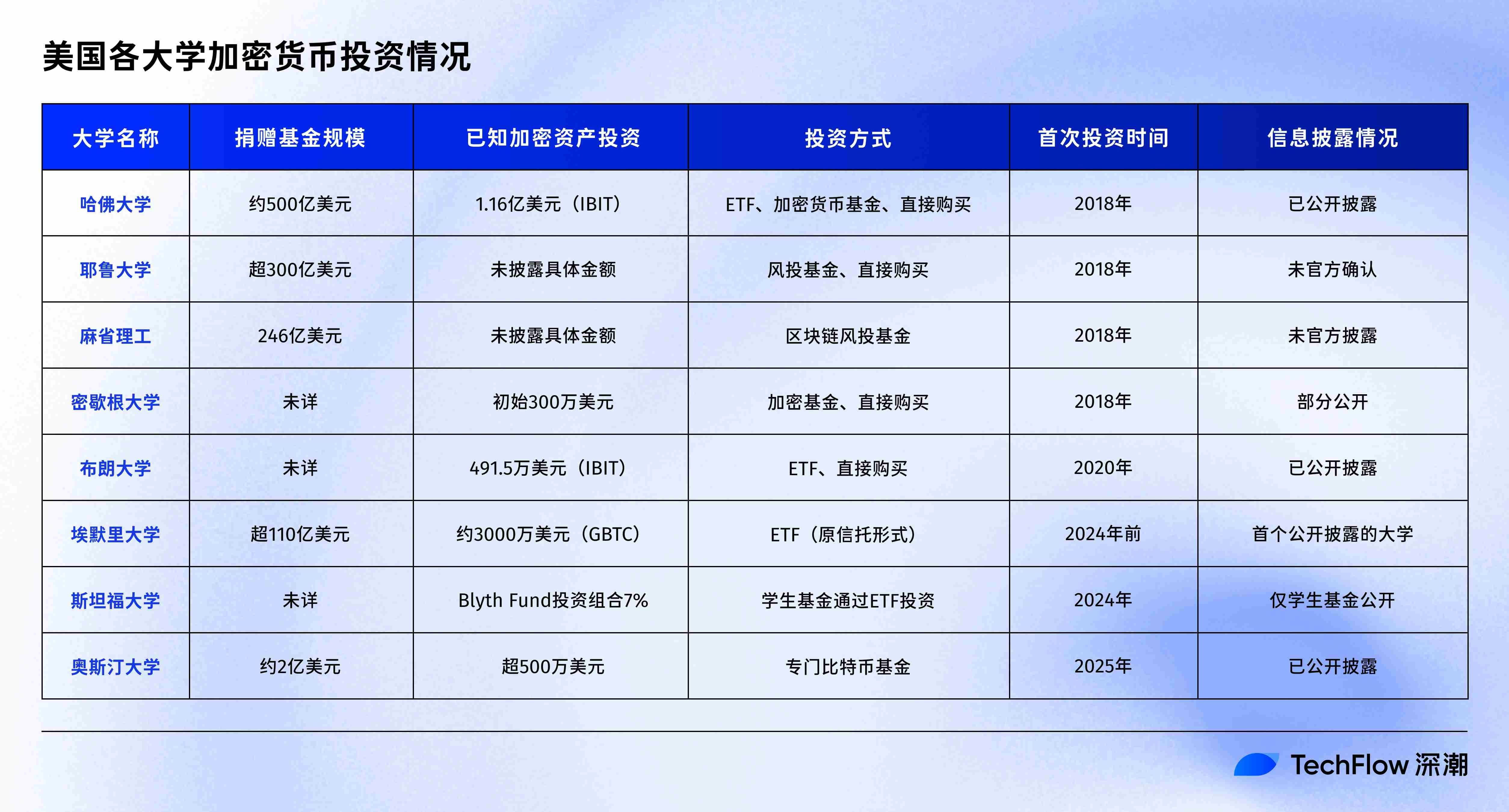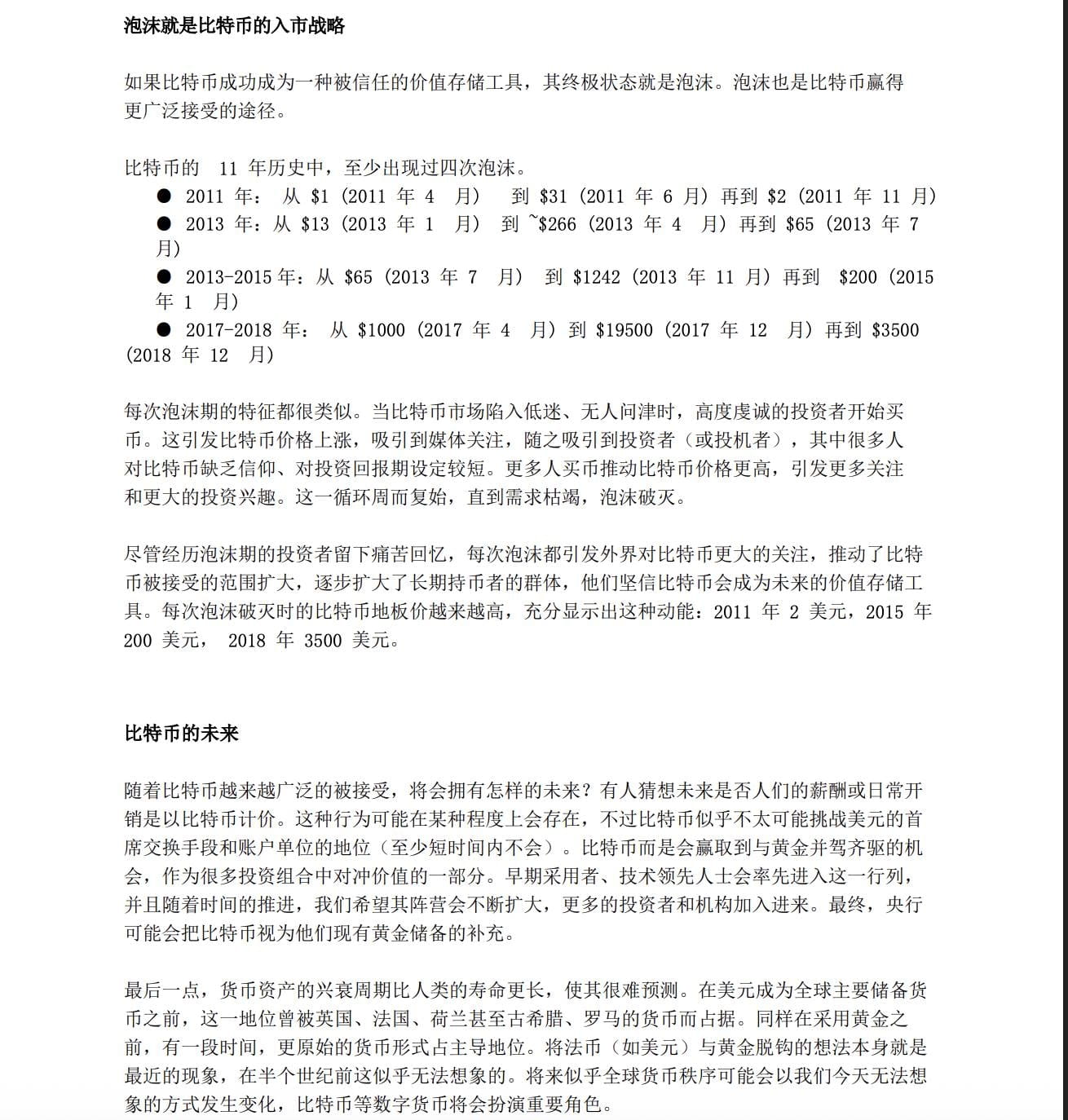Written by: Yanz, Liam
By August 2025, Bitcoin's price crossed $120,000, and the once 'marginal asset' was once again pushed onto the mainstream stage, driven not only by Wall Street's hedge funds but also by the most conservative and astute fund managers from Ivy League campuses.
On August 9, the U.S. Securities and Exchange Commission (SEC) 13F filing disclosed a detail that caught the market's attention: Harvard University's endowment fund (approximately $53.2 billion) held $116 million in Bitcoin ETFs (IBIT) in the second quarter of 2025. This position ranked as its fifth-largest investment, second only to Microsoft, Amazon, Booking Holdings, and Meta, even surpassing the holdings of Google's parent company Alphabet and Nvidia.
Harvard is not an isolated case.
Brown University, Emory University, and the University of Austin have all publicly disclosed cryptocurrency positions.

The 'miser' in these ivory towers embracing cryptocurrency is not an impulse, but rather the surface emergence of years of planning.
The capital, talent, and technology of prestigious universities have long taken root deep in the crypto industry.
Only this time, they were pushed to the forefront of the stage.
Investing in crypto amidst the bubble burst.
In 2018, the darkest moment of the cryptocurrency industry.
Amidst the burst of the ICO bubble, the global crypto asset market value evaporated by over $630 billion, dropping to under $200 billion, with Bitcoin falling to $3,000 and Ethereum dropping to $80. Retail investors fled the scene, and cryptocurrency was labeled as a 'Ponzi scheme', with even Facebook announcing a ban on cryptocurrency-related ads.
At this moment, when everyone was avoiding it, Yale University's endowment fund made what seemed to be a 'contradictory' decision.
Under the leadership of legendary investor David Swensen, in October 2018, Yale University, along with Harvard, Stanford, and other top schools, invested in the newly established Paradigm's first $450 million crypto fund, founded by Coinbase co-founder Fred Ehrsam and former Sequoia Capital partner Matt Huang. At the same time, Yale also participated in a16z's first crypto fund with a total amount of $400 million.
In retrospect, this investment during the low point not only influenced the development trajectory of Paradigm and a16z but also, to some extent, accelerated the historical progress of the crypto industry.
According to the original plan, Paradigm would allocate 60% of its funds to crypto assets and 40% to equity in crypto startups. However, after obtaining the funds, Paradigm chose a risky move—massively buying Bitcoin and Ethereum through the trading platform Tagomi, with an entry cost of around $4,000 for Bitcoin. Just a few months later, in the first half of 2019, Bitcoin's price briefly surpassed $10,000.
At that time, for university endowments, there was no way to directly purchase Bitcoin, nor were there compliant ETF products. Having Paradigm hold crypto assets on their behalf was a kind of 'indirect entry' strategy, allowing the foundation to isolate risks in terms of compliance and responsibility, even in the event of losses.
How exactly Matt Huang persuaded the Yale fund to invest in a newly established crypto fund for cryptocurrency investment seems to have always been a mystery.
Although Matt Huang's mother, Marina Chen, was a professor in the computer science department at Yale, there is no information to prove that Marina Chen influenced Yale's investment in Paradigm.
Through an article published by Matt Huang in 2020 (preaching Bitcoin to enlightened skeptics), we may glimpse how Matt Huang persuaded the heads of investment at various university funds back then.
In Matt Huang's view, bubbles are not flaws, but a necessary path for Bitcoin to gain wider acceptance. Each bubble has expanded Bitcoin's recognition and acceptance. Bitcoin will not challenge the dollar's status as a medium of exchange in the short term, but will eventually stand alongside gold as a hedging tool in investment portfolios, held by institutional investors, until central banks may eventually hold Bitcoin as reserves.

For the crypto industry, Paradigm is not just an investment institution that brings capital, but also an important builder.
In April 2019, Paradigm invested $1 million in Uniswap as a seed round lead investor. At that time, Uniswap had not even incorporated, and the only developer was founder Hayden Adams, a mechanical engineer who had just been laid off from Siemens and had only started self-learning Solidity in 2017.
Not just investing, Dan Robinson from Paradigm's research team almost spends every day in the Uniswap Discord, helping to solve liquidity and smart contract issues.
With the cooperation of both parties, the AMM model was born, igniting the DeFi summer.
Paradigm has invested in numerous star projects, including StarkWare, Mina, Uniswap, Compound, MakerDAO, Yield, Optimism, Amber, Fireblocks, Synthetix, Opyn, TaxBit, BlockFi, Chainalysis, Gitcoin, Lido, dYdX, and more.
Another crypto fund that Yale invested in early, a16z crypto, also shaped the industry's development, investing in well-known projects such as Coinbase, Solana, Aptos, Avalanche, Arweave, etc. In addition to investments, a16z has deeply participated in industry development through public policy influence, having donated tens of millions of dollars to the super PAC Fairshake, which supports crypto issues, and betting on Trump's victory to obtain a more favorable crypto policy environment.
Rewind to the end of 2018, the beginning of it all cannot be separated from the legendary investor David Swensen.
As the highest-paid person at Yale, he has managed billions of dollars in endowment funds over the past 34 years, expanding the fund's size from $1 billion to $31.2 billion, achieving an average annual return rate of nearly 17%.
His 'Yale Model' has become the gold standard for university endowment funds worldwide, and today, many heads of endowment funds at top institutions like Princeton, Stanford, MIT, and the University of Pennsylvania are former employees of his, known as the 'Yale School'.
Yale's entry quickly triggered a chain reaction. Harvard, Stanford, MIT, and other Ivy League schools followed suit. (The Information) reported at the end of 2018 that Harvard University, Stanford University, Dartmouth College, Massachusetts Institute of Technology, and the University of North Carolina all invested in at least one cryptocurrency fund through their respective endowment funds.
In a sense, Yale's investment in 2018 was not only a timely help during the industry's winter but also a high-profile vote of confidence in the future of the crypto industry.
The crypto gang in prestigious schools.
Apart from capital and endorsements, the deeper impact of the world's top universities on the crypto industry lies in people.
Where there are people, there is a world, and in the crypto world, many of the 'gang leaders' and backbone forces mostly come from prestigious universities, gradually forming a powerful 'university gang' that is invisible.
In the Chinese-speaking world, Tsinghua University is undoubtedly the most influential presence. Former Huobi founder Li Lin graduated from Tsinghua University's Department of Automation; the core team of the high-performance Layer 1 blockchain Conflux comes from Tsinghua's Yao Class; the two co-founders of blockchain security company CertiK, Gu Ronghui (CEO) and Shao Zhong (CTO), also graduated from Tsinghua.
Huobi founder Li Lin graduated from Tsinghua University's Department of Automation, while the founding team of the high-performance Layer 1 blockchain Conflux comes from Tsinghua's Yao Class. The two co-founders of blockchain security company CertiK, Gu Ronghui (CEO) and Shao Zhong (CTO), also graduated from Tsinghua.
Tron founder Sun Yuchen and Bitmain founder Wu Jihan both graduated from Peking University.
Zhejiang University's alumni projects are scattered across Web3 application ends, from the NFT trading platform Magic Eden to the NFT data platform NFTGo, from the popular chain game Stepn to the hardware wallet Keystone, almost covering multiple tracks of C-end applications.
Overseas, prestigious academic backgrounds are a standard for founders in the crypto industry.
The Stanford gang, leveraging Silicon Valley's central position, wields tremendous influence in the crypto industry, nurturing founders of star projects such as OpenSea, Alchemy, Filecoin, Story, and prominent industry leaders like Solana Foundation chair Lily Liu.
At the 2019 Stanford University blockchain conference, star sponsors gathered, with well-known projects and institutions such as Ethereum, Cosmos, and Polychain prominently featured, seemingly surpassing many large crypto conferences.

The MIT gang excels in technical research. MIT's Digital Currency Initiative team participated in the development of Zcash, which was selected by MIT in 2018 as one of the world's top ten breakthrough technologies. After all, zero-knowledge proofs (ZK), a milestone technology in cryptography, were proposed by MIT researchers in the 1980s.
MIT professor and Turing Award winner Silvio Micali personally stepped in to create the high-performance public chain Algorand in 2018.
The MIT alumni lineup can be described as a 'crypto star roster': Paradigm founder Matt Huang, MicroStrategy founder Michael Saylor, StarkWare co-founder Uri Kolodny, Litecoin founder Charlie Lee, and FTX founder SBF all hail from MIT.
UC Berkeley is extremely active in entrepreneurship and incubation.
In January 2019, Berkeley established the Berkeley Blockchain Xcelerator, jointly operated by the Berkeley Haas School of Business, Berkeley Engineering SCET, and Berkeley Blockchain, which incubates a batch of early-stage crypto projects each year, having accelerated over a hundred companies to date. Computer science professor Song Xiaodong even personally founded the privacy public chain Oasis Network. Other notable UCB projects include Galxe, Osmosis, Sei Network, Opyn, Ampleforth, Kadena, etc.
The Princeton gang has a profound influence in the investment field.
In 2022, four alumni from the class of 1987, Ethereum co-founder Joseph Lubin, Pantera Capital founder Daniel Morehead, Galaxy Digital founder Michael Novogratz, and Peter Briger of Fortress Investment Group, jointly donated $20 million to their alma mater to initiate a blockchain research program.
It's worth mentioning that when Morehead founded Pantera, he received early support from Briger and Novogratz. Today, Pantera is a top crypto fund managing over $5 billion in assets.
In an industry that emphasizes 'Don't Trust, Verify', trust between people becomes even more precious. Alumni relationships serve as a natural trust bond: founders are more inclined to hire alumni, and investors are more willing to invest in alumni, thereby forming an invisible barrier of 'gang culture'.
After Li Lin founded Huobi, he brought in classmates Lan Jianzhong and Zhu Jiawei. Over half of the executives come from Tsinghua, and the former CEO, Seven Ye, and CFO, Zhang Li, also graduated from Tsinghua. Wu Jihan similarly relies on Peking University classmates for assistance at Bitmain.
Today, blockchain courses have become standard in major universities, and student blockchain clubs interweave with alumni networks, forming an invisible web of talent and capital.
Stanford's CBR conference, Berkeley's Xcelerator, and MIT's DCI hackathon are continuously supplying new blood to the crypto world.
Not just early investors in the industry, universities have become the 'martial arts sects' of the crypto world.


